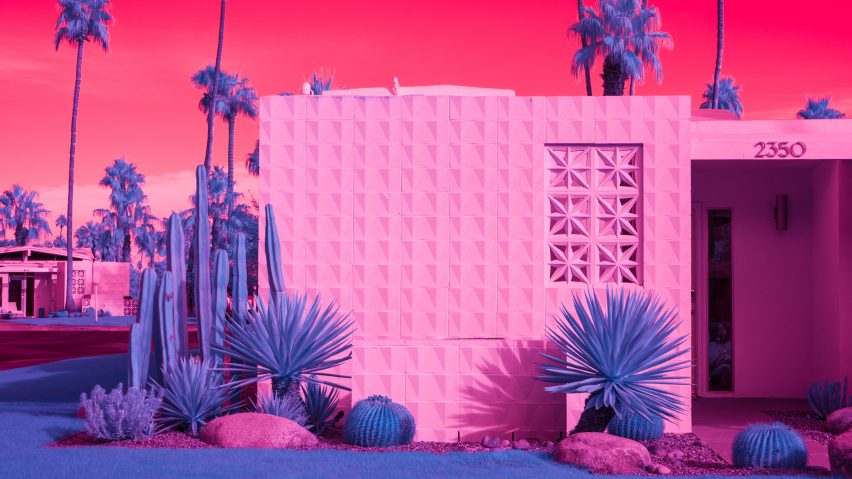Australian photographer Kate Ballis has toured Palm Springs with an infrared camera and coloured filters to produce these images, which show the muted desert city in lucid purple, pink and red tones.
Melbourne-based Ballis created the Infra Realism series to offer alternative views of Palm Springs' famed mid-20th century architecture, having captured its vistas many times previous.
"Palm Springs is almost a second home to me, so after photographing its deserts, houses, pools, and cars many times it started to become a bit ordinary," Ballis told Dezeen.
"Although I was still in love with the place, my wonderful friends, and mesmerised by the light on the mountains, it was no longer my artistic muse, and I really wanted to re-enchant the city and the high-desert landscapes."
The photographer bought a new digital Sony device and sent it off to be converted into a full-spectrum camera. This was able to capture infrared, or heat, radiation rather than visible light.
Ballis then added coloured filters over the lens, resulting in a set of surreal images featuring pink and purple buildings, blue shrubbery and red skies.
They show the city's well-known buildings – including like Richard Neutra's Kaufmann House and the private retreat designed by E Stewart Williams for Frank Sinatra – in a whole new light.
For example at the Palm Springs Tennis Club, the swimming pool is turned a deep, watery red hue, while the skin of the sunbathers is shown as mottled blue.
"I have subverted a technique used by many photographers who want to make infrared a more natural theme, and instead I have created a palette that is completely different to what we expect from a landscape," Ballis said.
"It took a good few days of playing with filters and techniques until I reached an aesthetic that made the series what it is," she said. "The colours I settled on for the series allowed me to question reality and create ambiguity in everyday scenes."
The photographer, who also documented the city's motels and apartment blocks, said that the infrared filter enabled her to pick up on details that she would otherwise miss.
The abundance of the vegetation in the desert city was a particularly surprising element.
"I started viewing Palm Springs as a lush oasis, where succulents and palm trees thrived and synthetic grass can be identified through the viewfinder from 100 metres away," she said.
"It has been fascinating to photograph a landscape that appears muted and dead, but realise that the shrubs and cactus are actually alive and well, and in infrared glowing brighter than anything else in the scene."
The strong contrast between the buildings and the planting works against an intention of desert modernist architecture, which was often built with natural materials and tones to match with the surrounding landscape. "What appears to the eye as a dusty brown scene is actually a glowing world," said Ballis.
She started her project last year during the annual Palm Springs Modernism Week, and has since expanded the series to include more famed modernist buildings in California, like the John Lautner-designed Sheats-Goldstein residence and the deserted landscapes of Joshua Tree National Park.
The architecture of Palm Springs is a popular subject of photographers, who have put various spins on the city through their images.
Australian photographer Tom Blachford ventured out after dark to capture the lines and lights of the buildings at night, while German photographer Stephanie Kloss put a retro twist on her images of the iconic mid-century homes.
This year's Palm Springs Modernism Week runs from 15 to 25 February 2018, and Dezeen is marking the occasion with a series of articles that spotlight the city's most important architecture. They have so far included the Tramway Gas Station by Albert Frey and Robson Chambers, John Lautner's Hope Residence and a Bank of America modelled on a Le Corbusier chapel.

